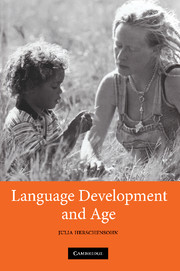Book contents
- Frontmatter
- Contents
- List of figures
- List of tables
- Preface
- Acknowledgments
- List of abbreviations
- 1 Just in time: is there a critical period for language acquisition?
- 2 Right on time: process and schedule of first language acquisition
- 3 All in good time: a window of opportunity for first language acquisition
- 4 Behind time: process and schedule of second language acquisition
- 5 Pressed for time: age constraints in second language acquisition
- 6 Biding time: further consideration of age and acquisition
- 7 It's about time: evaluation of age sensitivity in language acquisition
- Bibliography
- Index
7 - It's about time: evaluation of age sensitivity in language acquisition
Published online by Cambridge University Press: 22 September 2009
- Frontmatter
- Contents
- List of figures
- List of tables
- Preface
- Acknowledgments
- List of abbreviations
- 1 Just in time: is there a critical period for language acquisition?
- 2 Right on time: process and schedule of first language acquisition
- 3 All in good time: a window of opportunity for first language acquisition
- 4 Behind time: process and schedule of second language acquisition
- 5 Pressed for time: age constraints in second language acquisition
- 6 Biding time: further consideration of age and acquisition
- 7 It's about time: evaluation of age sensitivity in language acquisition
- Bibliography
- Index
Summary
Introduction
In the book of Genesis, just after Adam arrives in the Garden of Eden, he displays a command of vocabulary in naming all the animals. A little later he comments on his partner Eve: “This one at last is bone of my bones and flesh of my flesh. This one shall be called Woman, for from man was she taken” (Tanakh, 5). Adam improves substantially after his holophrastic period of animal naming to develop almost immediately a grammar using complete sentences with subordinate clauses, past tense and passive. A literal interpretation of Genesis – whatever literal might mean given the opacity of translations from the original Hebrew and the vagaries of individual exegesis – meets with as much success in describing the development of language as Shelley's account of Frankenstein's reanimation.
How the first humans came to have language is a question that relates both to ontogenetic development (the growth of individual language) and to phylogenetic (growth of the species' language). It is doubtful that we might learn how the first language developed, whether all at once by a mutated gene or in the gradual development of a symbolic system of communication, or by increases in brain size.
- Type
- Chapter
- Information
- Language Development and Age , pp. 211 - 241Publisher: Cambridge University PressPrint publication year: 2007



